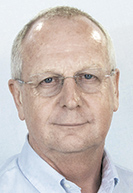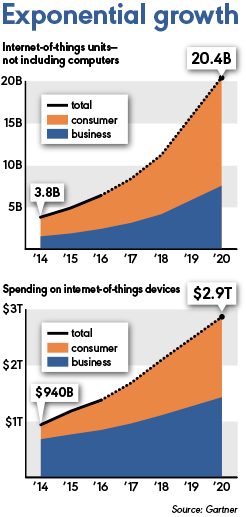Subscriber Benefit
As a subscriber you can listen to articles at work, in the car, or while you work out. Subscribe NowLast fall, Fishers Mayor Scott Fadness began noticing signs of an economy that’s undergoing slow but tectonic shifts.
He saw a Twitter post that claimed some Amazon shipments see only about 20 seconds of human interaction, mostly because of automation.
Separately, a friend at a think tank showed him a picture of a driverless semitrailer. Then he heard about an economic development announcement outside Indiana in which the company was investing $100 million in a new facility but adding only 200 jobs.
All of that got him thinking about the future of the workforce and the “internet of things,” a phrase that describes the emerging world of web-connected devices that are increasingly driving automation, big data and services. With that, Fadness saw both an opportunity and a threat.
“The consumers of IoT services are all right here—Cummins, Lilly, Roche, Allison, Wabash,” Fadness said, rattling off a list of Indiana’s biggest private-sector employers. “So that’s the opportunity.”
The threat? “A larger proportion of our population is employed by manufacturers than any other state in the union.
“So, we have to wonder: If, 10 years from now, automation and modernization do what we think they’re going to do because of IoT,” he said, “then where are Hoosiers going to gain access to meaningful employment?”
Fadness is one of the sparks that has ignited a massive effort to make Indiana a hub of IoT software, hardware and expertise.
He coined the catchphrase “make things, move things and grow things” to describe the state’s strengths in manufacturing, logistics and agriculture. He believes Indiana can lead a transformation of those industries through IoT.
The push has some prominent backers, including Gov. Eric Holcomb, the Indiana Chamber of Commerce, AT&T Indiana President Bill Soards, and a multitude of tech leaders inside and outside the IoT niche. Over the past six months, advocates have penned op-eds, given speeches and even pressed legislators about the importance of becoming an IoT hub.
But their concept of an IoT hub isn’t well-defined—and their ambitions vary.
Some want Indiana to be a world-class destination for IoT services and manufacturing, the place that comes to mind when people across the country hear the phrase. Others don’t think Indiana needs to be the place for IoT, but instead just one of the prominent places where IoT technology is developed.
 Halliday
HallidayBut advocates agree that all industries will be or are already being revolutionized by IoT, and they want to create a rich ecosystem of IoT companies and talent here to support that.
Industry leaders outside the state say that’s a wise effort.
“The question is, do you believe the internet of things is going to happen? And if you do, you need to be right on the cutting edge to make sure it happens for you,” said Steve Halliday, president of Virginia-based IoT consulting firm Hi Tech Aid.
“From the state and city standpoint, it’s really important to get involved very quickly to make sure the businesses in your area don’t suffer adversely because they’re not participating.”
What is IoT?
Web-connectivity marries traditional products and services to the power of the internet, often to allow for real-time monitoring or control.
Examples are as simple as internet-enabled thermostats that can be adjusted from a smartphone and sump pumps that warn homeowners about flooded basements. Web-enabled baby monitors, door locks and parking meters are in the mix. Fitness bands and internet-enabled toothbrushes are part of the sector, too, although they aren’t designed to be controlled remotely but instead to upload health data to cloud-based servers and send activity notices to users.
But some examples are much larger and more advanced.
Connected devices can sometimes talk to other devices and make decisions with little or no human input. One purpose: to predict problems and automate solutions. Manufacturers are developing diesel engines and HVAC systems, for instance, that sense mechanical problems and initiate responses such as automatically shipping a replacement part or scheduling a repair appointment.
 The world of internet-enabled devices is massive—and growing. Research firm Gartner said in February that 8.4 billion connected devices will be in use worldwide by the end of this year, up 31 percent from 2016. That figure is projected to reach 20.4 billion by 2020.
The world of internet-enabled devices is massive—and growing. Research firm Gartner said in February that 8.4 billion connected devices will be in use worldwide by the end of this year, up 31 percent from 2016. That figure is projected to reach 20.4 billion by 2020.
Next year, Gartner said, total spending on devices and services will top $2 trillion.
The potential for IoT goes beyond products that are electronic, like washing machines or cars. Even clothes and livestock can benefit from internet connectivity, said Halliday of Hi Tech Aid.
He is part of a global initiative to make small wireless transmitters called RAIN RFID tags the industry standard for implementing IoT on everyday items. These small and inexpensive tags can help stakeholders “identify, locate, authenticate and engage” virtually any item, he said, either by embedding the tags or attaching them.
With a simple wireless reader, a retailer or a farmer can streamline inventory management by counting and tracking items without having to scan each one. Anything with a tag, from boxes of bow ties to cases of blueberries, can be monitored wirelessly.
What’s an IoT hub?
But integrating IoT into a product or process often can be immensely complex.
A manufacturer that wants to design an internet-connected thermostat, for instance, has to consider the device’s hardware, the software that monitors and controls it, the user experience, data storage and management, cybersecurity, and more.
Many of those same considerations exist for a car-parts maker that wants to connect factory machinery to the internet.
The leaders of the movement to make Indiana an IoT hub want the state to be a rich base of expertise in all those areas.
They envision Indiana as a place where companies can go from IoT idea to product within their own back yard—and where out-of-town firms want to visit or set up offices to tap into the local knowledge.
The IoT hub they’re after includes involvement from investors, consultants, universities, not-for-profits and even government agencies.
“We need to have an environment where the right talent is available, the right funding is available, the right networks are available,” said Dattus CEO Anurag Garg, whose company helps industrial firms integrate IoT into their equipment.
“If you think about what makes Silicon Valley Silicon Valley, it’s not only access to talent and funding,” he said. “But it’s the fact that there’s an early-adopter market out there.”
The benefits of being an IoT hub are similar to the benefits of cornering any niche: new businesses, new jobs, new investments and an expanded tax base.
But advocates are driven by not just the benefits, but also the consequences of failing to advance the industry here. For one, observers said, companies in mature industries like manufacturing compete globally and risk becoming laggards to competitors in states that transform their businesses through IoT.
“One of the things we often see,” Halliday said, “is companies who sit back and say, ‘That’s fine. Once everyone is doing it, then we’ll join in.’ And then they find that their biggest competitor just cut its prices 30 percent because of efficiencies it’s seen, and they can’t compete and [they] go out of business.”
Can we do it?
Only time will tell if tech and civic leaders can create a teeming IoT hub, but they believe they’re starting with foundational strengths in manufacturing, logistics and agriculture.
Those three industries are ripe to be transformed through IoT, proponents argue, by using the internet to—as ClearObject CEO John McDonald put it—“make things better or make better things.”
Indiana has a multitude of small, midsize and large firms in those industries, including Rolls Royce, Cummins and Dow AgroSciences.
And IoT innovators inside and outside those companies have ample fodder for ideas.
The state also already has a number of IoT companies, like ClearObject, Mesh, Outside Source Design, Data Realty and others; each specializes in a service like data storage, analytics or user experiences.
Advocates say one of the state’s biggest advantages is the membership-based IoT Lab opening in Fishers this year. The idea is to create a space for innovators to conjure up IoT applications and connect with resources who can bring them to life. Its founding partners bill the lab as the only one of its kind.
Mark Hung, an analyst with Gartner, said many communities around the globe are vying to be “smart cities,” connecting municipal assets like streetlights and parking spots to the internet. But he’s less aware of community efforts to become dominant hubs for commercial IoT activity.
“Most tech hubs are very much focused on [a range of] software-related companies,” instead of hardware, he said.
But for all the state’s IoT advantages, tech leaders acknowledge a few areas where it’s lacking.
One big one: capital. Indiana already lags much of the country in venture capital investment, and its $2.5-million-per-deal average in 2016 ranked it 39 out of 50 states, according to PwC. Venture money, as opposed to bank loans, is considered the lifeblood of startups in emerging sectors such as IoT.
But corporate capital investment—the money established companies spend with IoT companies—is also important. Some Hoosier firms already contract with IoT vendors, but IoT executives say the local companies are still in the early stages in terms of experimentation and investment.
Gauging success
A related challenge is a slower-than-expected rate of IoT adoption, both by corporations and consumers. Consumers aren’t necessarily chomping at the bit for internet-connected coffeemakers, and manufacturers aren’t rushing to connect everything on their factory floor to the web.
Garg, of Dattus, said many of his prospective clients have only about 14 percent of their operations online.
In 2014, Gartner projected 25 billion connected devices by 2020. The most recent estimate is 20 billion.
“For industries and governments starting to look at IoT, I think the reality is starting to set in about how long it’s going to take and what kind of investment needs to be made,” said Hung of Gartner.
Todd Saxton, an associate professor of strategy and entrepreneurship at the Indiana University Kelley School of Business, said he commends the local IoT effort, but that it’s always a tall order when a community strives to be a center of gravity in a specific industry.
 Saxton
Saxton“There are other hubs, or at least efforts, in Singapore, Taipei, Toronto, Silicon Valley and Boston,” Saxton said. “So there’s a lot going on, and we’re far from being the first to recognize this opportunity, but that doesn’t mean that this isn’t a worthwhile effort and we shouldn’t be pursuing it.”
Advocates said they know other cities have similar goals, but they’re willing to take their shot and see where they land. Ken Miller, an enterprise consultant whose background includes IoT-related work, said simply hoping Indiana becomes an IoT hub is no strategy.
“When you look at the general disruption that’s coming with IoT, with automation, with [artificial intelligence] … they’re going to impact these physical businesses significantly,” he said. “And if we don’t, as a state and an economy, create a strategy about how we’re going to transition our core business sectors into the future, then we’re subject to random survival.”
No one has set a timetable for creating a local IoT hub, and measuring success depends on whom you ask.
Some cite abstract metrics, like seeing the area teem with IoT talent or having outside companies look here for IoT expertise.
But others want measurable signs, including the number of IoT-related companies, patents and venture capital investments.
“I tend to look toward more concrete things—businesses, economic activity, jobs, technology transfers, things like that,” said Mark Lawrence, the state chamber’s vice president of engagement and innovation policy.
Saxton, the IU professor, said one way to tell if the state has become an IoT hub is “when they stop talking about it. Because then it’s like, ‘Well, yeah, of course.’”•
Please enable JavaScript to view this content.
